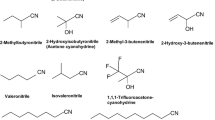Abstract
The initial reactions possibly involved in the acrobic and anaerobic metabolism of aromatic acids by a denitrifying Pseudomonas strain were studied. Several acyl CoA synthetases were found supporting the view that activation of several aromatic acids preceeds degradation. A benzoyl CoA synthetase activity (AMP forming) (apparent K m values of the enzyme from nitrate grown cells: 0.01 mM benzoate, 0.2 mM ATP, 0.2 mM coenzyme A) was present in aerobically grown and anaerobically, nitrate grown cells when benzoate or other aromatic acids were present. In addition to benzoate and fluorobenzoates, also 2-amino-benzoate was activated, albeit with unfavorable K m (0.5 mM 2-aminobenzoate). A 2-aminobenzoyl CoA synthetase (AMP forming) was induced both aerobically and anaerobically with 2-aminobenzoate as growth substrate which had a similar substrate spectrum but a low K m for 2-aminobenzoate (<0.02 mM). Anaerobic growth on 4-hydroxybenzoate induced a 4-hydroxybenzoyl CoA synthetase, and cyclohexanecarboxylate induced another synthetase. In contrast, 3-hydroxybenzoate and phenyl-acetate grown anaerobic cells appeared not to activate the respective substrates at sufficient rates. Contrary to an earlier report extracts from aerobic and anaerobic 2-aminobenzoate grown cells catalysed a 2-aminobenzoyl CoA-dependent NADH oxidation. This activity was 10–20 times higher in aerobic cells and appeared to be induced by 2-aminobenzoate and oxygen. In vitro, 2-aminobenzoyl CoA reduction was dependent on 2-aminobenzoyl CoA NAD(P)H, and oxygen. A novel mechanism of aerobic 2-aminobenzoate degradation is suggested, which proceeds via 2-aminobenzoyl CoA.
Similar content being viewed by others
References
Anderson JJ, Dagley S (1981) Catabolism of tryptophan, anthranilate, and 2,3-dihydroxybenzoate in Trichosporon cutaneum. J Bacteriol 146:291–297
Bradford MM (1976) A rapid and sensitive method for the quantitation of microgram quantities of protein utilizing the principle of protein-dye binding. Anal Biochem 72:248–254
Braun K, Gibson DT (1984) Anaerobic degradation of 2-aminobenzoate (anthranilic acid) by denitrifying bacteria. Appl Environ Microbiol 48:102–107
Cain RB (1966) Utilisation of anthranilic and nitrobenzoic acids by Nocardia opaca and a flavobacterium. J Gen Microbiol 42: 219–235
Cain RB (1968) Anthranilic acid metabolism by microorganisms. Formation of 5-hydroxyanthranilate as an intermediate in anthranilate metabolism by Nocardia opaca. Antonie van Leeuwenhoek 34:417–432
Dagley S (1985) Microbial metabolism of aromatic compounds. In: Moo-Young M (ed) Comprehensive biotechnology, vol 1. Pergamon, Oxford, pp 483–505
Evans WC (1977) Biochemistry of the bacterial catabolism of aromatic compounds in anaerobic environments. Nature (Lond) 270:17–22
Evans WC, Fuchs G (1988) Anaerobic degradation of aromatic compounds. Annu Rev Microbiol 42:289–317
Geissler JF, Harwood CS, Gibson J (1988) Purification and properties of benzoate-coenzyme A ligase, a Rhodopseudomonas palustris enzyme involved in the anaerobic degradation of benzoate. J Bacteriol 170:1709–1714
Gross GG (1981) Phenolic acids. In: Conn EE (ed) The biochemistry of plants, vol 7. Academic Press, New York, pp 301–316
Harwood CS, Gibson J (1986) Uptake of benzoate by Rhodopseudomonas palustris grown anaerobically in light. J Bacteriol 165:504–509
Hutber GN, Ribbons DW (1983) Involvement of coenzyme A esters in the metabolism of benzoate and cyclohexanecarboxylate by Rhodopseudomonas palustris. J Gen Microbiol 129:2413–2420
Jones GH (1987) Actinomycin synthesis in Streptomyces antibioticus: enzymatic conversion of 3-hydroxyanthranilic acid to 4-methyl-3-hydroxyanthranilic acid. J Bacteriol 169:5575–5579
Kobayashi S, Kuno S, Itada N (1964) O18 studies on anthranilate hydroxylase—a novel mechanism of double hydroxylation. Biochim Biophys Res Com 16:556–561
Kontake Y, Shirai Y (1953) Über die Entstehung der 5-Oxy-Anthranilsäure aus Anthranilsäure im tierischen Organismus. Hoppe-Seyler's Z Physiol Chemie 295:160–163
Schennen U, Braun K, Knackmuss HJ (1985) Anaerobic degradation of 2-fluorobenzoate by benzoate-degrading bacteria. J Bacteriol 161:321–325
Stanier RY, Ornston LN (1973) The β-ketoadipate pathway. Adv Microbiol Physiol 9:89–151
Tschech A, Schink B (1986) Fermentative degradation of monohydroxybenzoates by defined syntrophic cocultures. Arch Microbiol 145:396–402
Tschech A, Fuchs G (1987) Anaerobic degradation of phenol by pure cultures of newly isolated denitrifying pseudomonads. Arch Microbiol 148:213–217
Wheelis ML, Palleroni NJ, Stanier RY (1967) The metabolism of aromatic acids by Pseudomonas testosteroni and P. acidovorans. Arch Mikrobiol 59:302–314
Ziegler K, Braun K, Böckler A, Fuchs G (1987) Studies on the anaerobic degradation of benzoic acid and 2-aminobenzoic acid by a denitrifying Pseudomonas strain. Arch Microbiol 149:62–69
Author information
Authors and Affiliations
Rights and permissions
About this article
Cite this article
Ziegler, K., Buder, R., Winter, J. et al. Activation of aromatic acids and aerobic 2-aminobenzoate metabolism in a denitrifying Pseudomonas strain. Arch. Microbiol. 151, 171–176 (1989). https://doi.org/10.1007/BF00414434
Received:
Accepted:
Issue Date:
DOI: https://doi.org/10.1007/BF00414434




